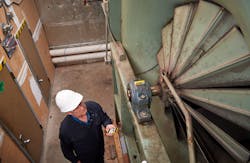The Internet of Things permeates our lives daily, changing the way we live by shifting how we connect and communicate with people or systems. The same holds true for the industrial internet of things (IIoT), which offers similar benefits when used to increase plant productivity and reliability.
“For automation, control, and process management, the industry has been collecting data and using it to inform actions for years,” said Kevin Clark, VP of Fluke Accelix. “The ‘newness’ of the IIoT is where the data can be stored—such as in the cloud—how it is analyzed, and then the capability to do something [with] it.”
There are several maintenance strategies associated with improving plant performance, including preventive and predictive maintenance (PM and PdM, respectively). Condition monitoring—part of predictive maintenance—uses sensors and software to identify current equipment state and performance abnormalities, such as increased vibration, temperature, pressure, and more.
Market trends dictate technology do more than simply provide measurements. Devices that can connect to online databases or third-party systems accelerate the change in existing reliability strategies. A truly connected framework is required to meet the demands of evolving facility environments.
A small pilot program is the best way to start harnessing the power of IIoT devices and can be mixed into existing maintenance programs. Select a few assets on which to install condition-monitoring sensors, then scale the program to meet the needs of the facility.
What Can Vibration Sensors Do?
IIoT-enabled, remote vibration sensors upload asset measurements to cloud-based software in real-time. Maintenance teams can use software to view, track, and trend equipment performance.
“We are looking for indications based on known values of the machine when it’s healthy and for deviations from that norm, [indicating] machine condition has changed from healthy to abnormal,” explained John Bernet, product application specialist at Fluke.
When connected to software, vibration monitoring sensors:
- Provide around-the-clock asset status
- Alert maintenance personnel to potential equipment issues
- Record historical data useful in identifying intermittent problems
“With vibration, we can see indications of faults 12 to 18 months in advance, when there is still life left in components,” Bernet said. “Condition monitoring gives you some prewarning and the ability to schedule corrective repairs
Condition monitoring devices are most effective when connected to computerized maintenance management software (CMMS) or enterprise asset management (EAM) systems for data organization. CMMS/EAMs capture and store aggregated data in one place. Software trends and graphs the measurements, so maintenance teams can make data-driven decisions.
Why Start with Vibration Sensors?
Change in vibration is a key indicator of equipment health and often tops the “why assets fail” list. Vibration comes from rotating components, adjacent machines, turbulent flows, foundations, structural resonances, noise, and other sources.
“Vibration analysis has been around for 30 or 40 years, so the anomalies of the four most common faults have all been proven and well-documented…The patterns are very easy to follow,” Bernet said. “This makes vibration [an ideal] technology to be able to find the most common problems with rotating machines.”
Using always-on vibration monitoring sensors to screen for problems provides early warnings of equipment behavior changes. Collected data allows users to compare real-time events with historical information to determine machine fault severity. Alarms provide a safety net to extreme conditional change, ensuring equipment never reaches the point of no return.
Catching Equipment in the Act
“A lot of machines are more computer-driven and they’re behind panels, and when you open the panel, the machine shuts down,” Bernet said. “We can’t take a measurement then because the machine shuts down.”
Additionally, problems might be intermittent and, therefore, difficult to catch using manual routes. Rather than hoping the equipment anomaly shows itself when the technician is present, wireless vibration sensors gather continuous data that can be viewed remotely using connected software. Real-time, automatically uploaded data points provide a different perspective.
Viewing vibration data, however, is not a cure-all. Elevated vibration levels could indicate any number of problems. Best practices suggest using multiple technologies to gain a comprehensive view of asset health. Vibration monitoring is just one way to identify equipment problems.
Connected reliability solutions such as Accelix track more than just vibration. With infrared, power, temperature, electrical, and vibration data mapped to the asset inventory and trended over time, reliability and maintenance managers have the key indicators for asset health on their screens always.
“Integration of data from multiple sources allows for faster and better maintenance decisions,” said Greg Perry, CMRP, CRL, senior consultant for Fluke Accelix.
What’s Important, What’s Not?
Implementation logistics should be fleshed out before adding condition monitoring. Each facility is different and encounters its own unique problems depending on machine usage and plant environments. Implementing any maintenance program or strategy should be made by individual operations, not as a one-size-fits-all application.
Condition monitoring success stories mention the importance of reviewing current facility maintenance status. What’s working, what’s not, and how will sensors help? Teams better understand the path of an enhanced maintenance program when they assess the current state.
Performing asset criticality analysis is also a key to success. Once reprioritized, many assets that may have seemed critical are found to merely be displaying the most problems. Properly identifying critical assets will help teams determine where to place condition monitoring sensors. Depending on the size of equipment, more than one sensor may be needed.
IIoT-Enhanced Systems Improve Safety
When workers can access asset condition data from their smart devices, they aren’t working within hazardous environments. The practice of removing workers from dangerous environments is a core element of safety and health program best practices, known as Hazard or Engineering Controls.
“A lot of machines don’t have easy access—they’re up in a high place, or in an area where there’s temperature, steam, or caustic materials, or behind a panel,” Bernet said.
Deploying IIoT-enhanced condition monitoring devices into existing programs means that technicians can check asset measurements from a safe distance. Furthermore, warnings from alarms provide teams ample time to get out to assets and into personal protective equipment before a failure occurs.
It All Adds Up
IIoT-enabled monitoring devices allow facilities to start maintaining equipment based on condition rather than by a schedule. This process is also known as condition-based maintenance, or CBM. Adding condition monitoring allows teams to gain insight into equipment behaviors and health, empowering them to make predictions and act before equipment fails.
Connected devices open the door to advanced maintenance connectivity. With the addition of each building block a well-constructed reliability strategy begins to form.
“The flexibility of current and emerging technology leaves no room for barriers,” Clark continues. “[Maintenance and reliability] professionals must be able to collect asset and system measurements however they want…This multisource information can then be automatically stored for future study and analysis... Interoperability is the key to ensuring that plants and other facilities have all the data they need in one place.”
The Industrial Revolution 4.0 (also known as “Maintenance 4.0” and “Industry 4.0”) will change the face of facility management and operation. The future of maintenance lies in using connected software and hardware to anticipate problems.
As technologies evolve, machine learning and artificial intelligence will further enhance maintenance decision making, allowing teams to truly predict impending problems. Implementing IIoT-enabled tools, sensors, and software is part of the path to predictive maintenance and connected reliability.
To learn more about connected reliability, click here.


